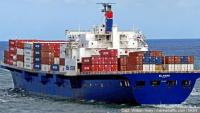 The National Transportation Safety Board announced Thursday that U.S. Navy salvage tug Apache has located the bridge deck of El Faro roughly a mile from the main wreckage of the ro/ro cargo ship. 33 crew died when the 790-foot long ship sank in Hurricane Joaquin in the beginning of October. The wreckage lies in approximately 15,000 of water or roughly a half mile deeper than the wreck of the Titanic. The tug Apache is equipped with side-scanning sonar and a remote operating vehicle or ROV capable of operating at these depths.
The National Transportation Safety Board announced Thursday that U.S. Navy salvage tug Apache has located the bridge deck of El Faro roughly a mile from the main wreckage of the ro/ro cargo ship. 33 crew died when the 790-foot long ship sank in Hurricane Joaquin in the beginning of October. The wreckage lies in approximately 15,000 of water or roughly a half mile deeper than the wreck of the Titanic. The tug Apache is equipped with side-scanning sonar and a remote operating vehicle or ROV capable of operating at these depths.
The search continues for the Voyage Data Recorder (VDR), often referred to as the “black box.” The VDR, which is, in fact, orange, would provide valuable information on what happened prior to the ship’s sinking. The VDR is designed to collect data from various sensors on board the vessel for the prior 24 hours.

You’d think they design one with an extra battery to last longer.
Also, if they had the ship’s plans on where it was installed onboard.
They might, I don’t know?
Before rushing to be first with a comment it is worthwhile to do some research on subjects, maritime in this case, with which one is clearly not overly familiar with.
Respectfully suggest researching Wikipedia on “Voyage Data Recorders” as to their size, positioning in vessels and designed capabilities.
Good Watch.
El Faro sank in the beginning of October. It was just over a month before they found the wreckage three miles below the surface. The VDR battery is designed to last for 30 days. VDR can either be fixed to the ship or designed to float free. The salvage team, no doubt, has been informed where the VDR was mounted. Given that the bridge deck was torn off when the ship sank, it is also possible that the VDR was damaged.